Check out our range of stock.
Didn't find what you like?
Send us a message
Found something out of stock?
Send us a message
![[ARRIVED 25 - JUL - 2025] 4BT31 - Red Fancy Halfmoon Plakat Male Betta *small* - Nano Tanks Australia](http://nanotanksaustralia.com.au/cdn/shop/files/arrived-25-jul-2025-4bt31-red-fancy-halfmoon-plakat-male-betta-small-9135945.jpg?v=1753440334&width=645)
Discover this rare betta fish for sale in Australia, exactly as shown in the photos. Each fish is healthy, vibrant, and full of personality—making it the perfect addition to your aquarium. Shipped safely from Sydney, our bettas are ready to thrive in your home tank. Specifications: Males: Approx. 4–5 cm | Giant bettas: 7–9 cm Females: Approx. 3–4 cm | Giant bettas: 7–9 cm Age: 3–6 months Origin: Imported from Indonesia or Thailand Important Notes: Koi, grizzle, and fancy bettas may naturally change colour and pattern as they grow or during transit. Long-fin varieties may occasionally nip their own tails—this is a natural behaviour. All fish are kept in Sydney tap water (23–26°C, pH ~7) to ensure they’re well-adjusted and healthy. Shipping: We ship live bettas from Sydney every Monday and Tuesday for the safest transit. Please see our Shipping Policy for more details. Optional Video:Want a closer look at your betta before purchase? Order a video of your exact fish through the link provided.
$20.00
![[ARRIVED 25 - JUL - 2025] 4BT32 - Red Fancy Halfmoon Plakat Male Betta - Nano Tanks Australia](http://nanotanksaustralia.com.au/cdn/shop/files/arrived-25-jul-2025-4bt32-red-fancy-halfmoon-plakat-male-betta-5351262.jpg?v=1753440334&width=645)
Discover this rare betta fish for sale in Australia, exactly as shown in the photos. Each fish is healthy, vibrant, and full of personality—making it the perfect addition to your aquarium. Shipped safely from Sydney, our bettas are ready to thrive in your home tank. Specifications: Males: Approx. 4–5 cm | Giant bettas: 7–9 cm Females: Approx. 3–4 cm | Giant bettas: 7–9 cm Age: 3–6 months Origin: Imported from Indonesia or Thailand Important Notes: Koi, grizzle, and fancy bettas may naturally change colour and pattern as they grow or during transit. Long-fin varieties may occasionally nip their own tails—this is a natural behaviour. All fish are kept in Sydney tap water (23–26°C, pH ~7) to ensure they’re well-adjusted and healthy. Shipping: We ship live bettas from Sydney every Monday and Tuesday for the safest transit. Please see our Shipping Policy for more details. Optional Video:Want a closer look at your betta before purchase? Order a video of your exact fish through the link provided.
$15.00
![[ARRIVED 25 - JUL - 2025] 4BT33 - Galaxy Koi Halfmoon Plakat Male Betta - Nano Tanks Australia](http://nanotanksaustralia.com.au/cdn/shop/files/arrived-25-jul-2025-4bt33-galaxy-koi-halfmoon-plakat-male-betta-7840433.jpg?v=1753440334&width=645)
Discover this rare betta fish for sale in Australia, exactly as shown in the photos. Each fish is healthy, vibrant, and full of personality—making it the perfect addition to your aquarium. Shipped safely from Sydney, our bettas are ready to thrive in your home tank. Specifications: Males: Approx. 4–5 cm | Giant bettas: 7–9 cm Females: Approx. 3–4 cm | Giant bettas: 7–9 cm Age: 3–6 months Origin: Imported from Indonesia or Thailand Important Notes: Koi, grizzle, and fancy bettas may naturally change colour and pattern as they grow or during transit. Long-fin varieties may occasionally nip their own tails—this is a natural behaviour. All fish are kept in Sydney tap water (23–26°C, pH ~7) to ensure they’re well-adjusted and healthy. Shipping: We ship live bettas from Sydney every Monday and Tuesday for the safest transit. Please see our Shipping Policy for more details. Optional Video:Want a closer look at your betta before purchase? Order a video of your exact fish through the link provided.
$59.00
![[ARRIVED 25 - JUL - 2025] 4BT34 - White Marble Halfmoon Plakat Male Betta - Nano Tanks Australia](http://nanotanksaustralia.com.au/cdn/shop/files/arrived-25-jul-2025-4bt34-white-marble-halfmoon-plakat-male-betta-4008291.jpg?v=1753440335&width=645)
Discover this rare betta fish for sale in Australia, exactly as shown in the photos. Each fish is healthy, vibrant, and full of personality—making it the perfect addition to your aquarium. Shipped safely from Sydney, our bettas are ready to thrive in your home tank. Specifications: Males: Approx. 4–5 cm | Giant bettas: 7–9 cm Females: Approx. 3–4 cm | Giant bettas: 7–9 cm Age: 3–6 months Origin: Imported from Indonesia or Thailand Important Notes: Koi, grizzle, and fancy bettas may naturally change colour and pattern as they grow or during transit. Long-fin varieties may occasionally nip their own tails—this is a natural behaviour. All fish are kept in Sydney tap water (23–26°C, pH ~7) to ensure they’re well-adjusted and healthy. Shipping: We ship live bettas from Sydney every Monday and Tuesday for the safest transit. Please see our Shipping Policy for more details. Optional Video:Want a closer look at your betta before purchase? Order a video of your exact fish through the link provided.
$15.00
![[ARRIVED 25 - JUL - 2025] 4BT35 - Red Fancy Halfmoon Plakat Male Betta - Nano Tanks Australia](http://nanotanksaustralia.com.au/cdn/shop/files/arrived-25-jul-2025-4bt35-red-fancy-halfmoon-plakat-male-betta-4462756.jpg?v=1753440334&width=645)
Discover this rare betta fish for sale in Australia, exactly as shown in the photos. Each fish is healthy, vibrant, and full of personality—making it the perfect addition to your aquarium. Shipped safely from Sydney, our bettas are ready to thrive in your home tank. Specifications: Males: Approx. 4–5 cm | Giant bettas: 7–9 cm Females: Approx. 3–4 cm | Giant bettas: 7–9 cm Age: 3–6 months Origin: Imported from Indonesia or Thailand Important Notes: Koi, grizzle, and fancy bettas may naturally change colour and pattern as they grow or during transit. Long-fin varieties may occasionally nip their own tails—this is a natural behaviour. All fish are kept in Sydney tap water (23–26°C, pH ~7) to ensure they’re well-adjusted and healthy. Shipping: We ship live bettas from Sydney every Monday and Tuesday for the safest transit. Please see our Shipping Policy for more details. Optional Video:Want a closer look at your betta before purchase? Order a video of your exact fish through the link provided.
$15.00
![[ARRIVED 25 - JUL - 2025] 4BT36 - White Marble Halfmoon Plakat Male Betta - Nano Tanks Australia](http://nanotanksaustralia.com.au/cdn/shop/files/arrived-25-jul-2025-4bt36-white-marble-halfmoon-plakat-male-betta-8531862.jpg?v=1753440334&width=645)
Discover this rare betta fish for sale in Australia, exactly as shown in the photos. Each fish is healthy, vibrant, and full of personality—making it the perfect addition to your aquarium. Shipped safely from Sydney, our bettas are ready to thrive in your home tank. Specifications: Males: Approx. 4–5 cm | Giant bettas: 7–9 cm Females: Approx. 3–4 cm | Giant bettas: 7–9 cm Age: 3–6 months Origin: Imported from Indonesia or Thailand Important Notes: Koi, grizzle, and fancy bettas may naturally change colour and pattern as they grow or during transit. Long-fin varieties may occasionally nip their own tails—this is a natural behaviour. All fish are kept in Sydney tap water (23–26°C, pH ~7) to ensure they’re well-adjusted and healthy. Shipping: We ship live bettas from Sydney every Monday and Tuesday for the safest transit. Please see our Shipping Policy for more details. Optional Video:Want a closer look at your betta before purchase? Order a video of your exact fish through the link provided.
$59.00
![[ARRIVED 25 - JUL - 2025] 4BT41 - Blue Red Tail Halfmoon Male Betta - Nano Tanks Australia](http://nanotanksaustralia.com.au/cdn/shop/files/arrived-25-jul-2025-4bt41-blue-red-tail-halfmoon-male-betta-4719392.jpg?v=1753440334&width=645)
Discover this rare betta fish for sale in Australia, exactly as shown in the photos. Each fish is healthy, vibrant, and full of personality—making it the perfect addition to your aquarium. Shipped safely from Sydney, our bettas are ready to thrive in your home tank. Specifications: Males: Approx. 4–5 cm | Giant bettas: 7–9 cm Females: Approx. 3–4 cm | Giant bettas: 7–9 cm Age: 3–6 months Origin: Imported from Indonesia or Thailand Important Notes: Koi, grizzle, and fancy bettas may naturally change colour and pattern as they grow or during transit. Long-fin varieties may occasionally nip their own tails—this is a natural behaviour. All fish are kept in Sydney tap water (23–26°C, pH ~7) to ensure they’re well-adjusted and healthy. Shipping: We ship live bettas from Sydney every Monday and Tuesday for the safest transit. Please see our Shipping Policy for more details. Optional Video:Want a closer look at your betta before purchase? Order a video of your exact fish through the link provided.
$38.00
![[ARRIVED 25 - JUL - 2025] 4BT42 - Red Halfmoon Male Betta - Nano Tanks Australia](http://nanotanksaustralia.com.au/cdn/shop/files/arrived-25-jul-2025-4bt42-red-halfmoon-male-betta-3224000.jpg?v=1753440334&width=645)
Discover this rare betta fish for sale in Australia, exactly as shown in the photos. Each fish is healthy, vibrant, and full of personality—making it the perfect addition to your aquarium. Shipped safely from Sydney, our bettas are ready to thrive in your home tank. Specifications: Males: Approx. 4–5 cm | Giant bettas: 7–9 cm Females: Approx. 3–4 cm | Giant bettas: 7–9 cm Age: 3–6 months Origin: Imported from Indonesia or Thailand Important Notes: Koi, grizzle, and fancy bettas may naturally change colour and pattern as they grow or during transit. Long-fin varieties may occasionally nip their own tails—this is a natural behaviour. All fish are kept in Sydney tap water (23–26°C, pH ~7) to ensure they’re well-adjusted and healthy. Shipping: We ship live bettas from Sydney every Monday and Tuesday for the safest transit. Please see our Shipping Policy for more details. Optional Video:Want a closer look at your betta before purchase? Order a video of your exact fish through the link provided.
$38.00
![[ARRIVED 25 - JUL - 2025] 4BT44 - Fancy Halfmoon Male Betta - Nano Tanks Australia](http://nanotanksaustralia.com.au/cdn/shop/files/arrived-25-jul-2025-4bt44-fancy-halfmoon-male-betta-2664907.jpg?v=1753440334&width=645)
Discover this rare betta fish for sale in Australia, exactly as shown in the photos. Each fish is healthy, vibrant, and full of personality—making it the perfect addition to your aquarium. Shipped safely from Sydney, our bettas are ready to thrive in your home tank. Specifications: Males: Approx. 4–5 cm | Giant bettas: 7–9 cm Females: Approx. 3–4 cm | Giant bettas: 7–9 cm Age: 3–6 months Origin: Imported from Indonesia or Thailand Important Notes: Koi, grizzle, and fancy bettas may naturally change colour and pattern as they grow or during transit. Long-fin varieties may occasionally nip their own tails—this is a natural behaviour. All fish are kept in Sydney tap water (23–26°C, pH ~7) to ensure they’re well-adjusted and healthy. Shipping: We ship live bettas from Sydney every Monday and Tuesday for the safest transit. Please see our Shipping Policy for more details. Optional Video:Want a closer look at your betta before purchase? Order a video of your exact fish through the link provided.
$38.00
![[ARRIVED 25 - JUL - 2025] 4BT45 - Red Fancy Halfmoon Plakat Male Betta - Nano Tanks Australia](http://nanotanksaustralia.com.au/cdn/shop/files/arrived-25-jul-2025-4bt45-red-fancy-halfmoon-plakat-male-betta-5681242.jpg?v=1753440334&width=645)
Discover this rare betta fish for sale in Australia, exactly as shown in the photos. Each fish is healthy, vibrant, and full of personality—making it the perfect addition to your aquarium. Shipped safely from Sydney, our bettas are ready to thrive in your home tank. Specifications: Males: Approx. 4–5 cm | Giant bettas: 7–9 cm Females: Approx. 3–4 cm | Giant bettas: 7–9 cm Age: 3–6 months Origin: Imported from Indonesia or Thailand Important Notes: Koi, grizzle, and fancy bettas may naturally change colour and pattern as they grow or during transit. Long-fin varieties may occasionally nip their own tails—this is a natural behaviour. All fish are kept in Sydney tap water (23–26°C, pH ~7) to ensure they’re well-adjusted and healthy. Shipping: We ship live bettas from Sydney every Monday and Tuesday for the safest transit. Please see our Shipping Policy for more details. Optional Video:Want a closer look at your betta before purchase? Order a video of your exact fish through the link provided.
$59.00
![[ARRIVED 25 - JUL - 2025] 4BT46 - Galaxy Koi Halfmoon Plakat Male Betta - Nano Tanks Australia](http://nanotanksaustralia.com.au/cdn/shop/files/arrived-25-jul-2025-4bt46-galaxy-koi-halfmoon-plakat-male-betta-8229136.jpg?v=1753440334&width=645)
Discover this rare betta fish for sale in Australia, exactly as shown in the photos. Each fish is healthy, vibrant, and full of personality—making it the perfect addition to your aquarium. Shipped safely from Sydney, our bettas are ready to thrive in your home tank. Specifications: Males: Approx. 4–5 cm | Giant bettas: 7–9 cm Females: Approx. 3–4 cm | Giant bettas: 7–9 cm Age: 3–6 months Origin: Imported from Indonesia or Thailand Important Notes: Koi, grizzle, and fancy bettas may naturally change colour and pattern as they grow or during transit. Long-fin varieties may occasionally nip their own tails—this is a natural behaviour. All fish are kept in Sydney tap water (23–26°C, pH ~7) to ensure they’re well-adjusted and healthy. Shipping: We ship live bettas from Sydney every Monday and Tuesday for the safest transit. Please see our Shipping Policy for more details. Optional Video:Want a closer look at your betta before purchase? Order a video of your exact fish through the link provided.
$59.00
![[ARRIVED 25 - JUL - 2025] Carp Gudgeons 2 - 3cm - Nano Tanks Australia](http://nanotanksaustralia.com.au/cdn/shop/files/arrived-25-jul-2025-carp-gudgeons-2-3cm-1816978.png?v=1753439846&width=645)
Identification There is considerable confusion over the identification of ‘carp gudgeons’ in southeastern Australia. Genetic studies in the early 2000s showed that there were several sexual species of carp gudgeon occurring in coastal and inland drainages in eastern Australia, as well as a range of hemiclonal unisexual hybrids. Many of the carp gudgeon groups formerly considered as ‘species’ were not formally described (e.g. Lake’s, Murray-Darling, and Midgley’s carp gudgeons), with one of these (Lake’s) now considered to only consist of hemiclonal hybrids. Because many of the hemiclonal and sexual lineages look very similar, for ~20 years carp gudgeons in the MDB have been combined into a generic group and referred to as ‘Hypseleotris spp‘ (i.e. Hypseleotris of undefined species). In late 2022 the taxonomic situation became clearer with five species formally described or redescribed, plus a range of hemiclonal hybrids identified. In the MDB there are four sexual species present (Western, Bald, Boofhead, and Cryptic carp gudgeons). As well as this there are multiple hemi-clonal unisexual lineages of hybrid origin between the latter three species. In some parts of the MDB up to three sexual species co-occur with three hemiclonal forms, all being captured in the same location. The combining in the scientific literature of all carp gudegons into a single group means that most published ecological information cannot be attributed to a particular species, but for one species that does not form hybrids (Western carp gudgeon) and the most recently discovered species (Bald carp gudgeon) some information can be accurately attributed. Consequently, apart from some information to aid identification, on this website, all but the two of the non-hybrid species (Western and Bald) are treated as a group. As a group, all carp gudgeons are small and laterally compressed, with a truncate to slightly rounded tail, and small, upturned mouths. Maximum total length varies from 40–70 mm (generally < 60 mm). They have two separate dorsal fins. Fin colouration and size varies between the males of each species, but usually the anal and dorsal fins have a series of coloured bands which can be white, bluish, or orange through red. Western and Cryptic carp gudgeons (and some hybrids) get red and orange colour on their caudal fins. Females of all species have clear fins, but in breeding season have bright yellow, orange or pink coloured bellies. Males of both Bald and Boofhead carp gudgeons (and some hybrid combinations) get very ‘boof-headed’, while Western carp gudgeon has a less blunt head profiles, and the head profile of Cryptic is round to pointed. Body colouration is yellowish-grey to greenish-brown and the scales of the upper sides and back have darker edges, giving a slightly reticulated appearance. Biology and Habitat The following account of biology and habitat is of information gathered before the taxonomy of the group was clarified, but in general is likely to apply to many of the species. This group of species is found in slow-flowing or still waters, normally associated with macrophytes or other aquatic vegetation (which provides cover). Two to three sexual species of carp gudgeon plus three hemiclonal hybrids often occur sympatrically. It is unknown how multiple sympatric carp gudgeon taxa divide habitat, food and other resources between them to maintain their individual populations. Carp gudgeons are generalist carnivores commonly feeding on chironomids, ostracods, copepods and cladocerans, and select habitats that provide optimal feeding opportunities (e.g. abundant biofilms which support preferred prey such as chironomids). Carp gudgeon species (other than Western carp gudgeon) lay between 200–600 eggs on a hard object near the substrate where the males guard them for 5–8 days until hatching. Larvae are ~3 mm at hatching. Recent investigations have demonstrated that large numbers of carp gudgeons attempt to move through fishways on the Murrumbidgee and Murray rivers. Whether these attempted movements simply reflect local dispersal movements is unknown. Low light levels (e.g. in road culverts) could be a barrier to carp gudgeon movement. A study in the Condamine and Macintyre rivers in the northern Basin found that carp gudgeons as small as 40 mm (TL) were recorded moving up to 13.7 km upstream over 12 months, with upstream movement of 11 km occurring over a maximum of 20 days and with some individuals moving 2 km in 4 days. Downstream movements of more than 6 km downstream over 8 months, were also recorded, Peak movement generally occurred in spring, with fish tending to move both upstream and downstream on all flows but more downstream movement occurred on natural (not irrigation) receding flows. Recent research into how the hemiclonal hybrids transmit their genome to offspring shows that either the maternal or paternal genome is selectively eliminated from the germ (reproductive) cells (ova or sperm), so only one genome is transmitted. Distribution and Abundance As a group, carp gudgeons are widespread and abundant at mid to lower elevations (up to 220–550 m) in the southern and central MDB, and up to 1000 m elevation in the northern MDB. Carp gudgeons comprised >50% of the fish catch in wetlands in SA, almost 5 times the abundance of the second commonest native species (Unspecked hardyhead). In the Sustainable Rivers Audit (2004-13), of the 27,441 carp gudgeons captured, 29% came from the lowlands (<250 m ASL); 40% from the slopes (250–700 m ASL); 18% from uplands (700–1000 m ASL) and 13% from montane sites (> 1000 m ASL). Virtually all the montane records were from the Border Rivers. Carp gudgeons comprised 13% of the total fish catch and were the second-most abundant native taxa caught (behind Bony herring) and overall were fourth behind Bony herring, Eastern gambusia and Carp). In the Murray Darling Basin Fish Survey 54,783 carp gudgeon have been caught between 2014/15 and 2021/22. They were recorded from 21 MDB river valleys (not the Avoca or the Wimmera) but were recorded from the Wimmera in the SRA. Carp gudgeons are also found in coastal streams from central NSW to northern Qld. Typically, most carp gudgeon species are common across the Basin. The distribution map shows all carp gudgeon records (sexual species and unsiexual hemiclones) to demonstrate the widespread range of this group. Potential Threats The group is widespread and abundant. Predation by alien fish such as Redfin perch in floodplain ponds/billabongs can significantly reduce local abundance. Alienation of floodplains and barriers to fish migration likely alter localised foodwebs localised abundance. General References Anderson et al. 1971; Balcombe & Closs 2000, 2004, 2016; Baumgartner 2003; Bertozzi et al. 2000; Dove 1998; Dove et al. 1997; Hutchison et al. 2008; Jones et al. 2017; Larson & Hoese 1996a; Majtánová et al. 2021; McCasker 2009, McCasker et al. 2014; Schmidt et al. 2011, 2013; Smith et al. 2009; Stoffels & Humphries 2003; Thacker et al. 2022; Thacker & Unmack 2005; Unmack 2000, Unmack et al. 2019; Vilizzi & Tarkan 2016.
$3.00
![[ARRIVED 26 - MAR - 2025] Assorted Comet Goldfish 5 - 6cm - Nano Tanks Australia](http://nanotanksaustralia.com.au/cdn/shop/files/arrived-26-mar-2025-assorted-comet-goldfish-5-6cm-153141.jpg?v=1742987915&width=645)
Fish Keeping Snapshot : Keeping Difficulty : Beginner Diet : Omnivores Temperament : Peaceful Max Size : 23-35cm Preferred Water Parameters : Water Temperature : 8-23 ⁰C pH Level : 6.5-7.5 General Hardness : Medium (100 - 200ppm) Description Comet Goldfish is an ideal aquarium fish for the beginners, very hardy and suitable for unheated tanks as well as garden ponds. The Comet Goldfish originated in Washington in the 1880s and is now the single most popular Goldfish variety. Coburg Aquarium's Live Fish and Aquarium Products delivered to your door. Features of Comet Goldfish: Comet have a singular forked tail with two tips Long back and sleek body designed for fast swimming Comets have much larger, showier fins. A comet’s tail is usually the same length as its body There’s a lot of variety with Comet Goldfish. The most common variants you’ll see are yellow, orange, white, and vibrant red. The Best Aquarium Size for Comet: A mature Comet require a standard rectangular tank of at least 100L. You can also start with a 50L tank for a juvenile. Keep in mind that tank size can vary greatly depending on how big or small the goldfish is and how many you plan to stock in the tank. After an Aquarium for your fish? Browse Aquarium Tank Selection here. Tank Mate Compatibility: Comet are very peaceful community dwellers. They are schooling fish, it’s best to have at least two. They are easily consumed by bigger fish, which view them as prey. Great tank mates include: Comet Rosy Barbs Black Widow Tetras Axolotl Zebra Danios Other Comets
$5.00
![[ARRIVED 26 - MAR - 2025] Assorted Dwarf Gourami Males 4 - 6cm - Nano Tanks Australia](http://nanotanksaustralia.com.au/cdn/shop/files/arrived-26-mar-2025-assorted-dwarf-gourami-males-4-6cm-256192.png?v=1742988227&width=645)
The dwarf gourami is a peaceful and shy fish. If you have a pair of them, the two fish will swim together. Dwarf gouramis are considered labyrinth fish, which means they breathe the air with a lung-like labyrinth organ and need to have access to the water's surface. If you proceed to breed this species, their complex bubble nests display impressive construction instincts. Species Overview Common Names: Dwarf gourami, flame gourami, powder blue gourami, red gourami, sunset gourami Scientific Name: Trichogaster Ialius Adult Size: 2 inches Life Expectancy: 4–6 years Characteristics Family Belontiidae Origin India, West Bengal, Assam, and Bangladesh Social Peaceful Tank Level Top, mid-dweller Minimum Tank Size 5 gallons Diet Omnivore, will eat algae Breeding Egglayer, bubble nest Care Intermediate pH 6.0 to 7.5 Hardness 4 to 10 dGH Temperature 72 to 82 F (22 to 28 C) Origin and Distribution Originating in India, West Bengal, Assam, and Bangladesh, the dwarf gourami are native to thickly vegetated waters. They are often found together with other gourami species in the genus Trichogaster (also known as Colisa). In the river plains of northern India, larger species of gouramis are one of the most common food fish and are sold dried or as fish-meal in many markets. Colors and Markings Its common name "dwarf" fits this fish well, as it is one of the smallest of the gouramis. Males are slightly larger than females and have a bright orange-red body with turquoise-blue, vertical stripes that extend into the fins. Females remain a duller, silvery blue-gray color and never achieve the male's brilliant colors. Several color variants have been developed by selective breeding at fish farms, including solid light blue (powder blue), neon, rainbow, and red/blushing. Powder blues are predominately blue with only a little red showing on the body. Neons display a brighter blue pattern than the standard variety. Rainbows have especially brilliant orange-red bodies with blue stripes, in addition to a green-gold metallic sheen. Reds (flame gouramis) are almost solid red throughout the body with solid blue dorsal fins. Tankmates This species is usually peaceful and can be kept with other species that are not too large or aggressive. Other brightly colored species can sometimes cause male gouramis to become aggressive as they are mistaken for rivals. Peaceful, small schooling fish are suitable tank mates as well as most bottom-dwelling fish. Some potential tankmates may include dwarf cichlids, cardinal tetras, or neon tetras. Dwarf Gourami Habitat and Care Dwarf gouramis are well suited to smaller aquariums as well as community aquariums. Gouramis can be skittish when subjected to noise and should be kept in a quiet location. Provide plenty of vegetation, including floating plants that cover only part of the surface of the water, as these labyrinth fish need access to the surface of the aquarium to breathe air. Dwarf Gourami Diet and Feeding In nature, gouramis eat small insects and larvae from the surface of the water and graze on algal growth on rocks and plants. In captivity, they will eat flake food, freeze-dried food, frozen foods, and vegetable tablets. To maintain good health, supplement their diet with periodic feedings of live foods such as worms. Live foods should also be used to condition breeder pairs. Gender Differences Males are generally larger than females and more vividly colored. As males reach maturity, they develop elongated dorsal and anal fin tips that come to a point. In females, these fins are shorter and rounded. Breeding the Dwarf Gourami Lowering the water level to 6 to 8 inches and raising the water temperature to 82 degrees Fahrenheit will trigger spawning. Vegetation is essential as male gouramis construct bubble nests out of plant materials, which they then bind together with bubbles. Nests are very elaborate and sturdy, reaching several inches across and an inch deep. For aquarium plants, Limnophila aquatica, Riccia fluitans, Ceratopteris thalictroides, and Vesicularia dubyana are good choices for the breeding tank. You can also offer peat fiber as a building material. Once the nest has been built, the male will begin courting the female, usually in the afternoon or evening. He signals his intentions by swimming around the female with flared fins, attempting to draw her to the nest where he will continue his courting display. If the female accepts the male, she will begin swimming in circles with the male beneath the bubble nest. When she is ready to spawn, she touches the male on either the back or the tail with her mouth. Upon this signal the male will embrace the female, turning her first on her side and finally on her back. At this point, the female will release approximately five dozen clear eggs, which are immediately fertilized by the male. Most of the eggs will float up into the bubble nest. Eggs that stray are collected by the male and placed in the nest. Once all the eggs are secured in the nest, the pair will spawn again. If more than one female is present in the breeding tank, the male may spawn with all of them. The spawning sessions will continue for two to four hours and produce between 300 and 800 eggs. Upon completion, the male will place a fine layer of bubbles beneath the eggs, assuring that they remain in the bubble nest. At this point, the female(s) should be removed from the tank to reduce stress on the male. The male will then take sole responsibility for the eggs, aggressively defending the nest and surrounding territory. In 12 to 24 hours the fry will hatch and continue developing within the protection of the bubble nest. After three days they are sufficiently developed to be free-swimming. Remove the male from the tank once the fry have left the bubble nest, or he may consume the young. Feed the fry on micro-foods such as infusoria, rotifers, or commercial fry food for the first week. After a week, they can be fed freshly hatched brine shrimp and finely ground flake foods.
$15.00
![[ARRIVED 26 - MAR - 2025] Assorted Fantail 5 - 7cm - Nano Tanks Australia](http://nanotanksaustralia.com.au/cdn/shop/files/arrived-26-mar-2025-assorted-fantail-5-7cm-536172.jpg?v=1742987997&width=645)
Introducing the Assorted Fantail 5cm - a collection of vibrant and dynamic fish that thrive in coldwater environments. With its stunning colors and energetic nature, this fish will bring life to your aquatic space. Perfect for those seeking a unique and captivating addition to their home aquarium. Species Overview Common Names: Fantail goldfish, double tail goldfish Scientific Name: Carassius auratus Adult Size: 7 inches Life Expectancy: 10 to 15 years Characteristics Characteristics Family Cyprinidae Origin Asia Social Peaceful Tank Level Top, mid-dweller Minimum Tank Size 20 gallons Diet Omnivore Breeding Egg layer Care Easy pH 6.0 to 9.0 Hardness 6 to 12 dGH Temperature 55 to 80F (10 to 27 C)
$6.00

Assorted Guppies (Poecillia Reticulata) Our Assorted Guppies are locally bred, they are all mixed genetics and offer a range of colours. The General types that may be available are: Cobras Neon blue Japanese double sword Full Gold Dumbos And many other colours that doesn't fit our strict breeding schedule If you have a preference you can let us know in the notes and we will try our best.When buying Guppies we recommend either going all males or a ratio of 1 male to 2 females or more. this is to ensure the females are not getting too stressed out by the males who will constantly chase them wanting to breed. Temperature: 24 – 28°C pH: 6.5 – 7.8 Hardness: 8-12 dGH Lifespan: 2+ years Size: 3.5cm Diet: Omnivore Image from: aquaticarts
$7.00
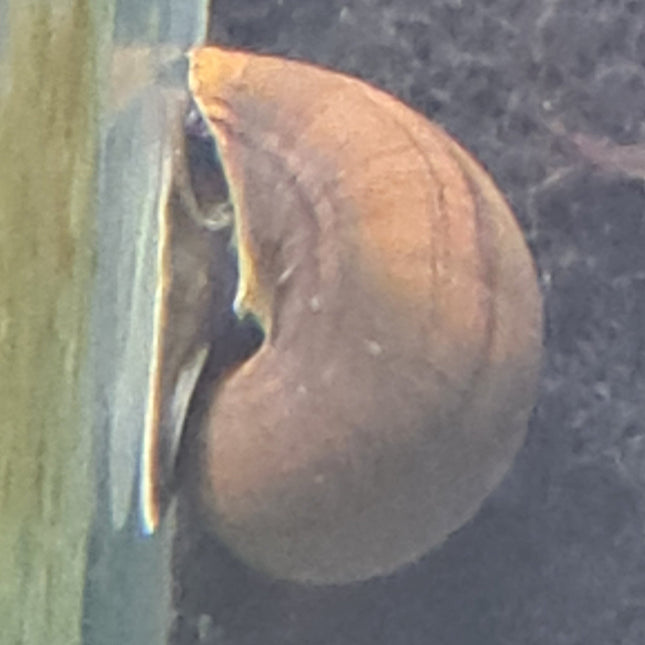
The Black-Brown-Black-Footed Mystery Snail is an aquatic snail found in freshwater habitats in Europe and North America. It is a small snail, typically measuring between 1-2 cm in diameter and its shell is a dark brown or blackish color with a white band near the opening. Its foot is a creamy white color and it has two tentacles on its head and two eyes on the sides of its head. This snail feeds on algae, bacteria and detritus, and it is often used in aquariums as a natural cleaner. It is a hardy species and can survive in a variety of water conditions. Care Level: BeginnerTemperament: CalmColoUr Form: Brown, Black, Blue, Purple, Gold and WhiteLifespan: One YearSize: 2 InchesDiet: HerbivoreFamily: AmpullariidaeMinimum Tank Size: 5 GallonTank Set-Up: Moderate Vegetation, AdaptableCompatibility: Community Tanks
$8.00
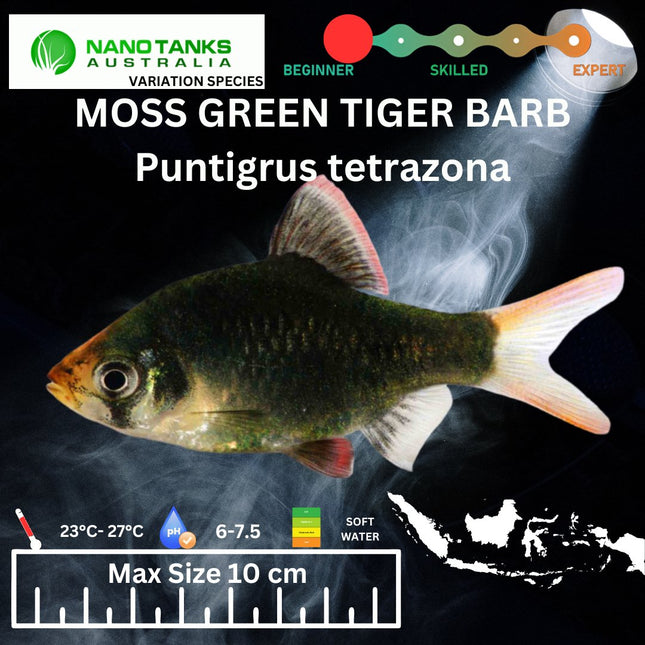
Appearance Tiger Barbs have an iconic look that even novice fish-keepers will instantly recognize. The body of the fish is quite wide. It’s tallest at the middle point and tapers down to a triangular-shaped snout. These fish are also quite colorful and have a very distinct pattern. The base color of Tiger Barbs is usually golden yellow. Some also have subtle rose gold tint. On top of that base color are several stripes. Care Tiger Barb care isn’t too difficult and can be handled by aquarists without much experience (assuming you stick to the recommendations in this guide). Otherwise, they wouldn’t be as widespread as they are! In general, these fish are relatively hardy and can adapt to simple setups as long as you cover the basics. That said, there are some aspects of their care that’ll require a bit of special attention. Despite their small size and beautiful looks, their strong personalities can be a handful! Here are the main care recommendations you need to know. Tank Size The minimum tank size for a small group of Tiger Barbs should be at least 20 gallons. However, we recommend going with a 30-gallon tank if you can. As we mentioned earlier, these fish are avid swimmers. The more room they have, the better. Plus, ample room to swim may help stave off aggressive behavior. Water Parameters In the wild, you can find Tiger Barbs inhabiting lakes, streams, and swamps that are lined with trees. Thanks to the decaying plant matter in the water, conditions tend to be more acidic. For the best results, you need to mimic their natural environment as closely as possible. That includes getting the water conditions just right. Luckily, the Tiger Barb can tolerate a generous range of conditions. As long as you stick within the following ranges, your fish should have no problem staying healthy. Water temperature: 68°F to 82°F degrees (aim for around 74°F if possible) pH levels: 6.0 to 8.0 (a slightly acidic 6.5 is best) Water hardness: 4 to 10 dKH To ensure that the aquarium has the proper water parameters you should invest in a reliable and accurate test kit. This will help you have confidence in the readings you’re getting, allowing you to make the right adjustments when necessary.
$9.00

These Blue Pinoy Zebras are a variety of Pterophyllum scalare, which originated from the Amazon Basin, Orinoco Basin and various rivers in the Guiana Shield in tropical South America and are thus freshwater fish. Angelfish distinguish themselves from other cichlids in that they are strong laterally compressed, yet have a round body and elongated triangular dorsal and anal fins. These elegant yet strikingly shaped fish are popular with both beginner and experienced aquarists alike, and are a joy to observe. When buying Angels for breeding purposes, it is recommended to buy a group of 6 and let them pair off naturally. Once a pair is formed either move them to a breeding tank or sell off the others. Temperature: 24 – 28°C pH: 6.5 – 7.8 Lifespan: 10+ years Size: 10cm + Diet: Omnivore
$15.00
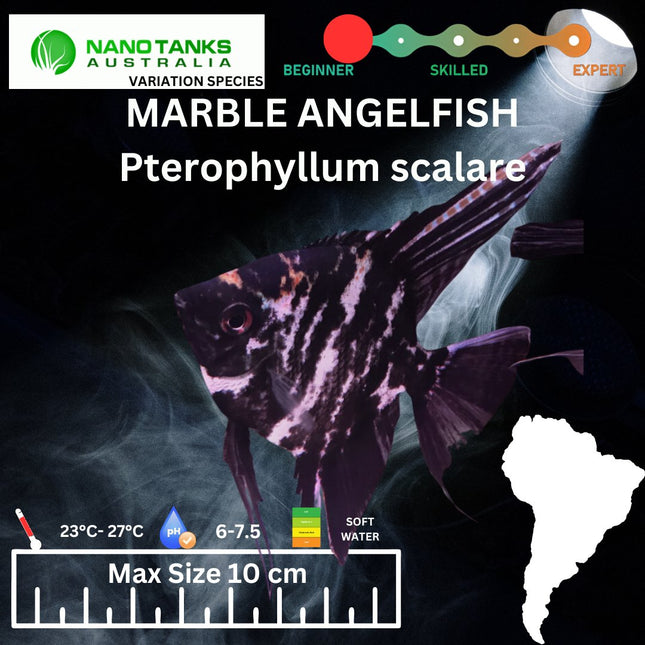
Discover the unique beauty of the Marble Angelfish. With its mesmerizing marble patterns, this fish is a stunning addition to any aquarium. Known for its docile nature, it is a peaceful fish that brings a sense of calm to any tank. Get ready to be captivated by this elegant species.
$15.00
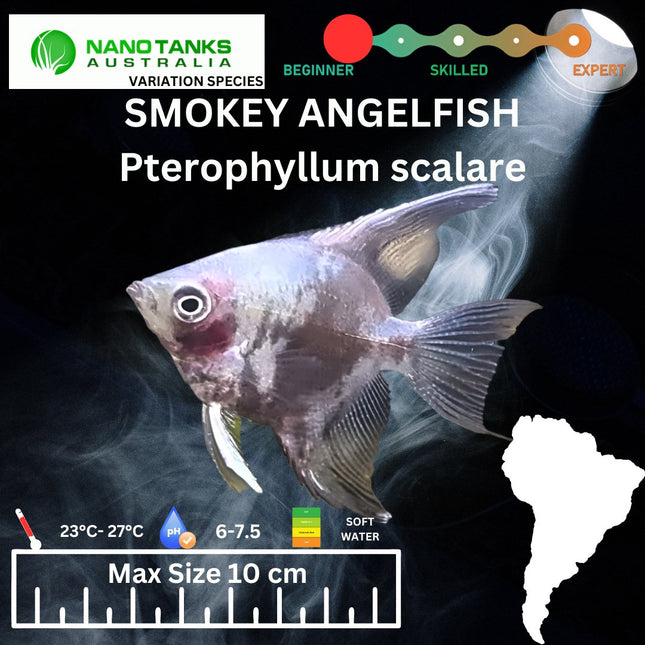
These Smokey Angels are a variety of Pterophyllum scalare, which originated from the Amazon Basin, Orinoco Basin and various rivers in the Guiana Shield in tropical South America and are thus freshwater fish. Angelfish distinguish themselves from other cichlids in that they are strong laterally compressed, yet have a round body and elongated triangular dorsal and anal fins. These elegant yet strikingly shaped fish are popular with both beginner and experienced aquarists alike, and are a joy to observe. When buying Angels for breeding purposes, it is recommended to buy a group of 6 and let them pair off naturally. Once a pair is formed either move them to a breeding tank or sell off the others. Temperature: 24 – 28°C pH: 6.5 – 7.8 Lifespan: 10+ years Size: 10cm + Diet: Omnivore
$10.00
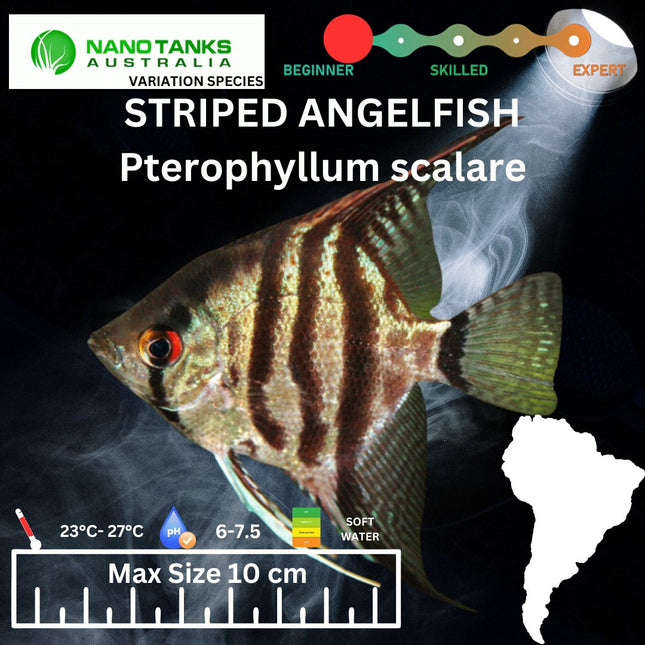
The Blue Sapphire Angelfish is a variety of Pterophyllum scalare, which originated from the Amazon Basin, Orinoco Basin and various rivers in the Guiana Shield in tropical South America and are thus freshwater fish. Angelfish distinguish themselves from other cichlids in that they are strong laterally compressed, yet have a round body and elongated triangular dorsal and anal fins. Sapphires grow to a moderate size, generally about 15cm long and can be kept in community tanks quite safely. These elegant yet strikingly shaped fish are popular with both beginner and experienced aquarists alike, and are a joy to observe. When buying Angels for breeding purposes, it is recommended to buy a group of 6 and let them pair off naturally. Once a pair is formed either move them to a breeding tank or sell off the others. Temperature: 24 – 28°C pH: 6.5 – 7.8 Lifespan: 10+ years Size: 10cm + Diet: Omnivore
$15.00
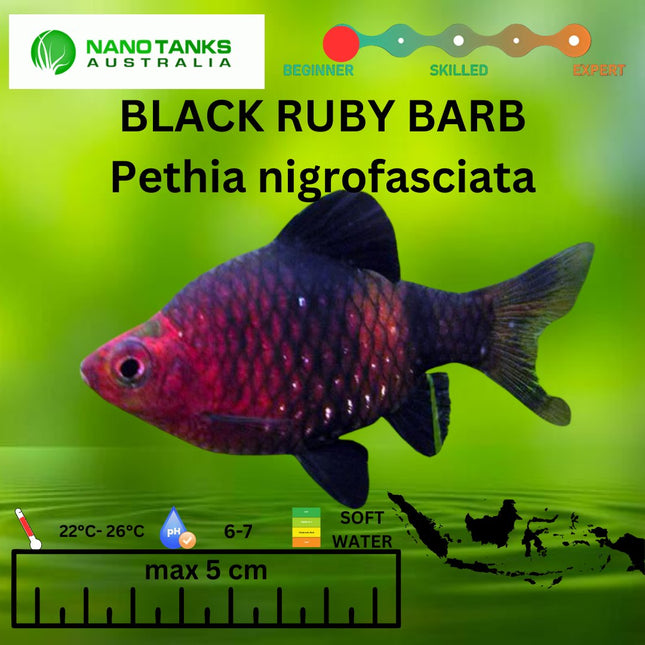
Please note the pictures depicts adult fish. Juvies are cream coloured with white stripes Origin and Distribution The ruby barb originates in Sri Lanka, where it was once plentiful in the forest streams in the upper elevations of the Kelani and Niwala river basins. This native habitat is composed of dense vegetation and slow-moving waters, which are colder than many tropical areas. The water in these streams is soft and acidic, and the river beds are composed of sand or fine gravel. Unfortunately, populations have greatly diminished due to over-catching by those selling these fish for export in the aquarium trade. Rapid deforestation has also eliminated much of the original habitat of these beautiful fish. At one point, they were on the brink of extinction but are currently listed as vulnerable by the International Union for Conservation of Nature (IUCN). Only with proper conservation methods will they remain as a viable population in the wild. As of 2020, the export of wild-caught ruby barbs from Sri Lanka is prohibited. All specimens sold in the aquarium trade are commercially bred, either in Sri Lanka or in a number of other countries that commercially breed aquarium fish. This commercial breeding has resulted in the creation of a variety of new colors and fin morphs compared with the wild fish. Colors and Markings Possessing a pointed head, high back, and deep body, the ruby barb is similar in body type to other banded barbs, such as the tiger barb. Three wide black bands run vertically through the body. In juvenile fish, the body is a pale yellow to yellow-gray. As the fish matures, the head becomes purple-red in color. In males, the entire body assumes this deep red color once they attain breeding age. Both sexes will pale in color when they are stressed, frightened, or are suffering from a disease or poor care. It is quite common for specimens in pet shops to appear washed out, then regain their bright coloration when taken to a quieter environment in a home aquarium. This species does not have barbels, which are feelers near the mouth or nasal cavity, like other barbs. Family Cyprinidae Origin Sri Lanka Social Peaceful Tank Level Bottom Minimum Tank Size 30 gallon Diet Filamentous algae and detritus Breeding Egg-scatterer Care Easy pH 6.0 to 6.5 Hardness 5 to 12 dGH Temperature 72 to 79 F (22 to 26 C)
$9.00
![[PREORDER 10 - APR - 2025] Gold Lace Glass Belly Short Body Guppy (Sold as pairs) - Nano Tanks Australia](http://nanotanksaustralia.com.au/cdn/shop/files/preorder-10-apr-2025-gold-lace-glass-belly-short-body-guppy-sold-as-pairs-943192.jpg?v=1744311715&width=645)
YELLOW LACE GLASS BELLY SHORT BODY IS CONSIDER NEW STRAIN THAT COMING TO GUPPY HOBBYIST MARKET. SMALL THAN OTHER GUPPY BUT THE SIZE AND THE UNIQUE MAKE IT MORE WANT BY THE GUPPY COLLECTORS.
$25.00 - $60.00

This is a variation of the Zebra Danio The Zebrafish (Danio rerio) is a freshwater fish belonging to the minnow family (Cyprinidae) of the order Cypriniformes. Native to South Asia, it is a popular aquarium fish, frequently sold under the trade name Zebra Danio (and thus often called a "tropical fish" although both tropical and subtropical). The Zebrafish is native to fresh water habitats in South Asia where it is found in India, Pakistan, Bangladesh, Nepal and Bhutan. The northern limit is in the South Himalayas, ranging from the Sutlej river basin in the Pakistan–India border region to the state of Arunachal Pradesh in northeast Indian. Its range is concentrated in the Ganges and Brahmaputra River basins, and the species was first described from Kosi River (lower Ganges basin) of India. Its range further south is more local, with scattered records from the Western and Eastern Ghats regions. It has frequently been said to occur in Myanmar (Burma), but this is entirely based on very old records (most recent from 1926) and likely refers to close relatives only described later, notably Danio kyathit. Likewise, old records from Sri Lanka are highly questionable and remain unconfirmed. The Zebrafish is named for the five uniform, pigmented, horizontal, blue stripes on the side of the body, which are reminiscent of a zebra's stripes, and which extend to the end of the caudal fin. Its shape is fusiform and laterally compressed, with its mouth directed upwards. The male is torpedo-shaped, with gold stripes between the blue stripes; the female has a larger, whitish belly and silver stripes instead of gold. Adult females exhibit a small genital papilla in front of the anal fin origin. The Zebrafish can reach up to 4–5 cm (1.6–2.0 in) in length, although they typically are 1.8–3.7 cm (0.7–1.5 in) in the wild with some variations depending on location. Its lifespan in captivity is around two to three years, although in ideal conditions, this may be extended to over five years. In the wild it is typically an annual species. Source: Wikipedia contributors. (2019, September 18). Zebrafish. In Wikipedia, The Free Encyclopedia. Retrieved 05:30, October 19, 2019, from https://en.wikipedia.org/w/index.php?title=Zebrafish&oldid=916415364
$8.00 $4.00

The Orca Aquarium Net Carbon Bag is a great way to add even more carbon filtration to your aquarium. This bag is designed to fit most small and medium-sized aquariums and comes with a convenient zipper closure. The small bag measures 6" x 9" and is perfect for smaller tanks. The bag is made of a strong and sturdy polyester material that is designed to trap and reduce odors and dissolved organics. The bag is also designed with a high-efficiency carbon-filtration system that will help keep your tank water clean and crystal clear. The bag can be easily hung over the side of the tank or placed inside to help keep your aquarium environment as healthy as possible.
$6.00
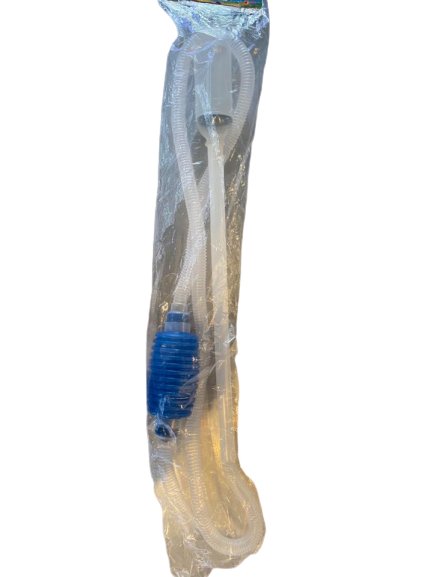
A hand-siphon is a device used to transfer liquids from one container to another. It consists of a flexible tube with one end inserted into the container holding the liquid and the other end in the new container. The tube is connected to a pump, which is operated by hand and uses suction to draw the liquid through the tube and into the new container. This can be used for tasks such as transferring fuel from a gas can to a lawn mower, filling a pool with water, or even emptying a fish tank. Hand-siphons are relatively inexpensive and easy to use, making them a useful tool for a variety of tasks.
$12.00

The Zebrafish (Danio rerio) is a freshwater fish belonging to the minnow family (Cyprinidae) of the order Cypriniformes. Native to South Asia, it is a popular aquarium fish, frequently sold under the trade name Zebra Danio (and thus often called a "tropical fish" although both tropical and subtropical). The Zebrafish is native to fresh water habitats in South Asia where it is found in India, Pakistan, Bangladesh, Nepal and Bhutan. The northern limit is in the South Himalayas, ranging from the Sutlej river basin in the Pakistan–India border region to the state of Arunachal Pradesh in northeast Indian. Its range is concentrated in the Ganges and Brahmaputra River basins, and the species was first described from Kosi River (lower Ganges basin) of India. Its range further south is more local, with scattered records from the Western and Eastern Ghats regions. It has frequently been said to occur in Myanmar (Burma), but this is entirely based on very old records (most recent from 1926) and likely refers to close relatives only described later, notably Danio kyathit. Likewise, old records from Sri Lanka are highly questionable and remain unconfirmed. The Zebrafish is named for the five uniform, pigmented, horizontal, blue stripes on the side of the body, which are reminiscent of a zebra's stripes, and which extend to the end of the caudal fin. Its shape is fusiform and laterally compressed, with its mouth directed upwards. The male is torpedo-shaped, with gold stripes between the blue stripes; the female has a larger, whitish belly and silver stripes instead of gold. Adult females exhibit a small genital papilla in front of the anal fin origin. The Zebrafish can reach up to 4–5 cm (1.6–2.0 in) in length, although they typically are 1.8–3.7 cm (0.7–1.5 in) in the wild with some variations depending on location. Its lifespan in captivity is around two to three years, although in ideal conditions, this may be extended to over five years. In the wild it is typically an annual species. Source: Wikipedia contributors. (2019, September 18). Zebrafish. In Wikipedia, The Free Encyclopedia. Retrieved 05:30, October 19, 2019, from https://en.wikipedia.org/w/index.php?title=Zebrafish&oldid=916415364
$8.00 $4.00
![Sunkist Cherry Shrimp 1 - 3cm 1 - 3cm [NO SHIPPING TO WA OR TAS] - Nano Tanks Australia Aquarium Shop](http://nanotanksaustralia.com.au/cdn/shop/files/sunkist-cherry-shrimp-1-3cm-1-3cm-no-shipping-to-wa-or-tas-154148.jpg?v=1738181824&width=645)
General care for shrimp: Temperature:18°-24°C Chlorine/chloramines: 0 ppm (very toxic for shrimp) Ammonia/Nitrite: 0 ppm. Nitrate: <20 ppm. pH: 6.2-7.5. GH: 4-8 dGH KH: 3-15 dKH Name Optimal TDS Limits Cherry shrimp 150 – 200 100 – 400 Cardinal shrimp 100 50 – 150 Tiger shrimp 180 – 220 100 – 300 We strongly recommend to drip acclimate any shrimp untill the TDS matches before you release the shrimp into your tank. Please note the above is just a general indication of the care requirements of shrimp. Results will vary depending on the individuals set up. Image by: Leah Cattarin NO SHIPPING TO WA
$12.00 $9.00
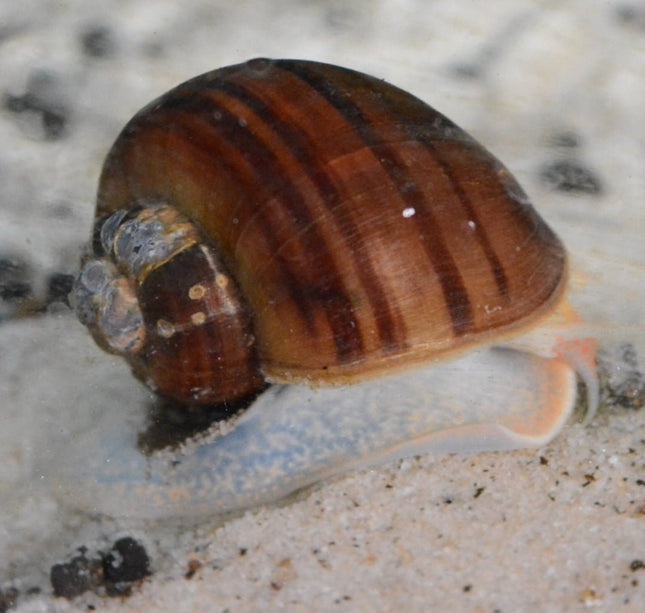
Care Level: BeginnerTemperament: CalmColour Form: Brown, Black, Blue, Purple, Gold and WhiteLifespan: One YearSize: 2 InchesDiet: HerbivoreFamily: AmpullariidaeMinimum Tank Size: 5 GallonTank Set-Up: Moderate Vegetation, AdaptableCompatibility: Community Tanks Reference: https://www.fishkeepingworld.com/mystery-snail/ Image: https://m.liveaquaria.com/images/categories/large/lg89931AlbinoMysterySnail.jpg
$5.00
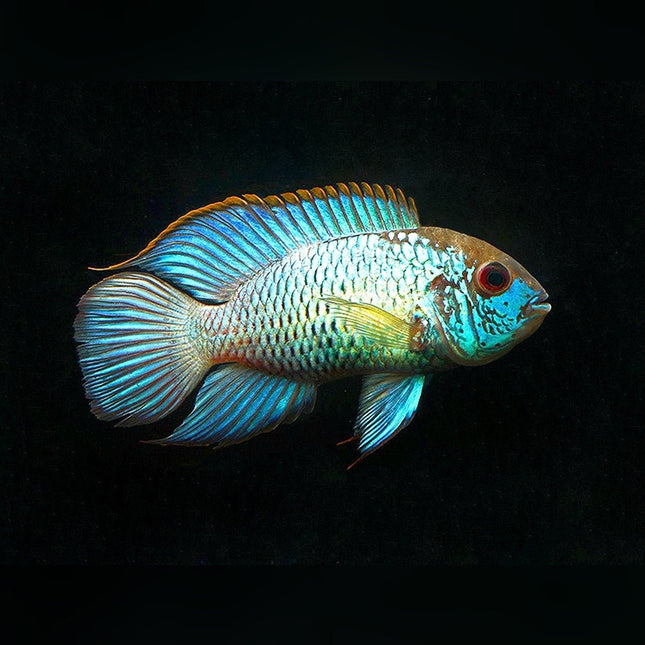
The Blue colour morph of the Pulcher cichlid is fairly new to the Australian Market. Blue Acaras are generally easy to keep if you are familiar with south american fish. Generally they are relatively peaceful just keep them fish other Americans their own size. Telling gender is relatively easy on mature fish. Males will be larger and develop a slightly pointed dorsal and anal fin, females are generally smaller and have a more rounded appearance. South American cichlid native to Venezuela and the island of Trinidad. It is one of the more peaceful of the South American cichlids and can be kept in a community aquarium with less aggressive American cichlids. This is an imposing robust species native to Central America. Best kept in large aquaria with similar sized American Cichlids, Plecostomus etc. Provide plenty of hiding places as they can be territorial. Like most American Cichlids, the Black Belt's colours intensify as they mature. Grows to 25-30cm.More than 225 species, with estimates of 300 species, of cichlids are found throughout South America. An estimated 75% of these inhabit the mighty Amazon River Basin. Cichlids are also found in Central America, where they are well-known for their pugnacious behavior and their stunning colors. Most of these cichlid are large, thus requiring large tanks. These fish inhabit most types of water ways throughout Central America including lakes, streams, rivers, even underground water sources.Their colorful appearance, the many different species available, their behavior and their breeding are just some of the reasons the Cichlids are one of the most popular aquarium fish.Due to their aggressive behavior, the tank for cichlids should be as large as possible, with its length being more critical than its height; meaning the longer the better.In the Cichlid tank there must be places of refuge. These can be rock caves, large pieces of driftwood or even inverted flowerpots. Most large species of Cichlids will dig up the substrate material, and occasionally will remove plants from the substrate. The Angelfish, Discus and the dwarf species Apistogramma all prefer a densely planted tank.The water temperature should be in the range of 24-28 degrees celsius, slightly higher for the Discus. The diet should consist of live and frozen food of all kinds as well a large flake staple food. Large specimens can be feed Earthworms, garden Crickets and kitchen leftovers.
$15.00

The Platinum Angelfish is a beautiful and unique freshwater fish that is native to South America. It has a deep, silvery body with a yellowish-white stripe down its back, and its fins are edged in bright white. Its tail is long and flows gracefully, giving it a veil-like appearance. It has a pointed nose and its eyes are a vibrant orange. It is a peaceful fish that is perfect for community aquariums and can get along with other species. It enjoys swimming in open areas and hiding in plants and decorations. It is an omnivore and requires a varied diet of both meaty and vegetative foods.
$15.00
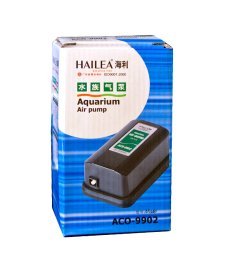
Description: Single Outlet 2.5 L/min Manufacturer: Hailea Features Small compact single outlet air pump for aquariums Modern compact design. Simple setup and operation, quick start. All models come with rubber feet, to avoid vibration. Reliable. Power usage: 2.2 watts Pressure: >0.01Mpa Size: 129x70x58mm Please remember to always use a check valve or non return valve.
$16.00
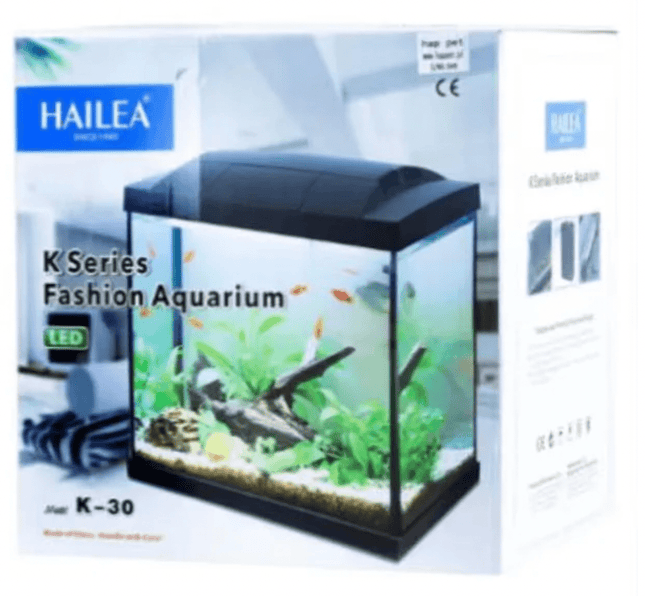
The HAILEA range includes aquariums suitable for beginners and for more experienced fish keepers. K-30 Package contents: Glass aquarium - LED illumination - 3 W Suspension filter HE-200 Internal Hang on filter 3w-200l/hr Dimensions: 36 x 24 x 31cm with folding lid Volume: 30 l Weight: 7 kg Black colour Pickup price quoted. If you require shipping please enquire
$169.00 $149.00

The HAILEA range includes aquariums suitable for beginners and for more experienced fish keepers. K-60 Package contents: Glass aquarium - LED illumination -5 W Suspension filter HE400 7W 380L/Hr Hinged Lid Dimensions: 59 x 31 x 45.6 cm (W x D x H) Volume: 60l Weight: 12kg Black colour
$260.00

Rasboras maculatus (the Spotted Rasbora) is a fish native to Southeast Asia. It is a peaceful schooling fish that is often kept in aquariums. It has a distinctive black spot on its caudal fin, and its body is a metallic silver color. It can reach up to 1.5 inches in length, and it is an omnivore. This fish is relatively easy to care for and can live up to 5 years in captivity. It is a popular and active fish that can add color and activity to an aquarium.
$6.50
You have seen 1656 out of 1935 products